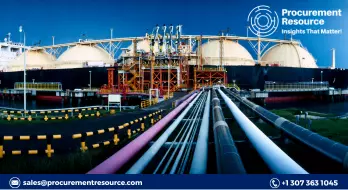Russia-Ukraine War Enlivens the LNG Production in Europe due to the Lacuna Created by Eradicating Russia Imports

In response to the ongoing conflict in Ukraine, global energy dynamics are undergoing significant shifts, particularly in the liquefied natural gas (LNG) sector. A notable incident in July showcased the ripple effects of international tensions on global LNG markets.
An LNG ship destined for Bahía Blanca, Argentina, was denied entry because its cargo, sourced from the Geneva-based company Gunvor, originated from Russia — a nation under sanctions due to its invasion of Ukraine in 2022. Argentina's Economy Minister, Sergio Massa, justified the move, pointing to the sanctions against Russian firms.
Request Access For the Latest Price Trends of Liquefied Natural Gas
This incident underscores the global apprehension about energy dependence on Russia. Approximately 3% of the global natural gas market comes from Russian exports. This has prompted nations, especially in Europe, to pivot towards LNG as an alternative source for their energy needs, driving a surge in demand.
Europe is fast-tracking its infrastructure to accommodate this LNG pivot, with new terminals rapidly emerging. The EU's regasification capacity is now close to 170 billion cubic meters, sufficient to counterbalance the deficit created by reduced Russian gas, although at steeper prices. Furthermore, an additional 130 Bcm of import capacity is on the horizon, including numerous projects centered on floating storage regasification units.
The EU is not the only region bolstering its energy security. Japan, a significant LNG importer, has initiated discussions with the EU to forge a global LNG strategy and establish an early warning system for potential supply disruptions.
However, the shift is not without challenges. Demand from Asia continues to outpace supply, suggesting that the global LNG market will remain constricted, and prices elevated until 2025-2026. A reprieve isn't anticipated until around 2027. Despite this, the crisis is ushering in new production avenues.
Notably, the US is expanding its footprint in the LNG market, with projects in Louisiana and Texas expected to double the nation's LNG capacity by 2030. This could potentially position the US as the leading global LNG provider.
Concurrently, East Asian countries, including Japan, South Korea, and Taiwan, previously accounting for over 40% of global LNG trade between 2015 and 2022, are pivoting to renewables to decrease their LNG reliance and attain their decarbonization targets. This strategic shift is evident in South Korea's ambition to cut its LNG-based electricity generation from 30% in 2021 to 9.3% by 2036.
Read More About Liquefied Natural Gas Production Cost Reports - Get Free Sample Copy in PDF
The upheaval in Ukraine and its subsequent ramifications indicate that the LNG market is poised for transformative change. Predicting the exact contours of the sector in the next decade remains speculative, but change is unequivocally on the horizon.
According to Procurement Resource, the Ukraine crisis has undeniably catalyzed significant shifts in the global energy paradigm, especially within the LNG sector. As nations grapple with energy security concerns and strive to diminish dependence on Russian gas, the pivot towards LNG has gained momentum.
Europe's infrastructure advancements, Asia's escalating demand, and the US's prospective dominance in LNG production all signify a tumultuous yet transformative period for the industry. Concurrently, East Asia's tilt towards renewables reflects a broader global move toward sustainability. The energy landscape of the next decade promises evolution, resilience, and strategic reinvention.



